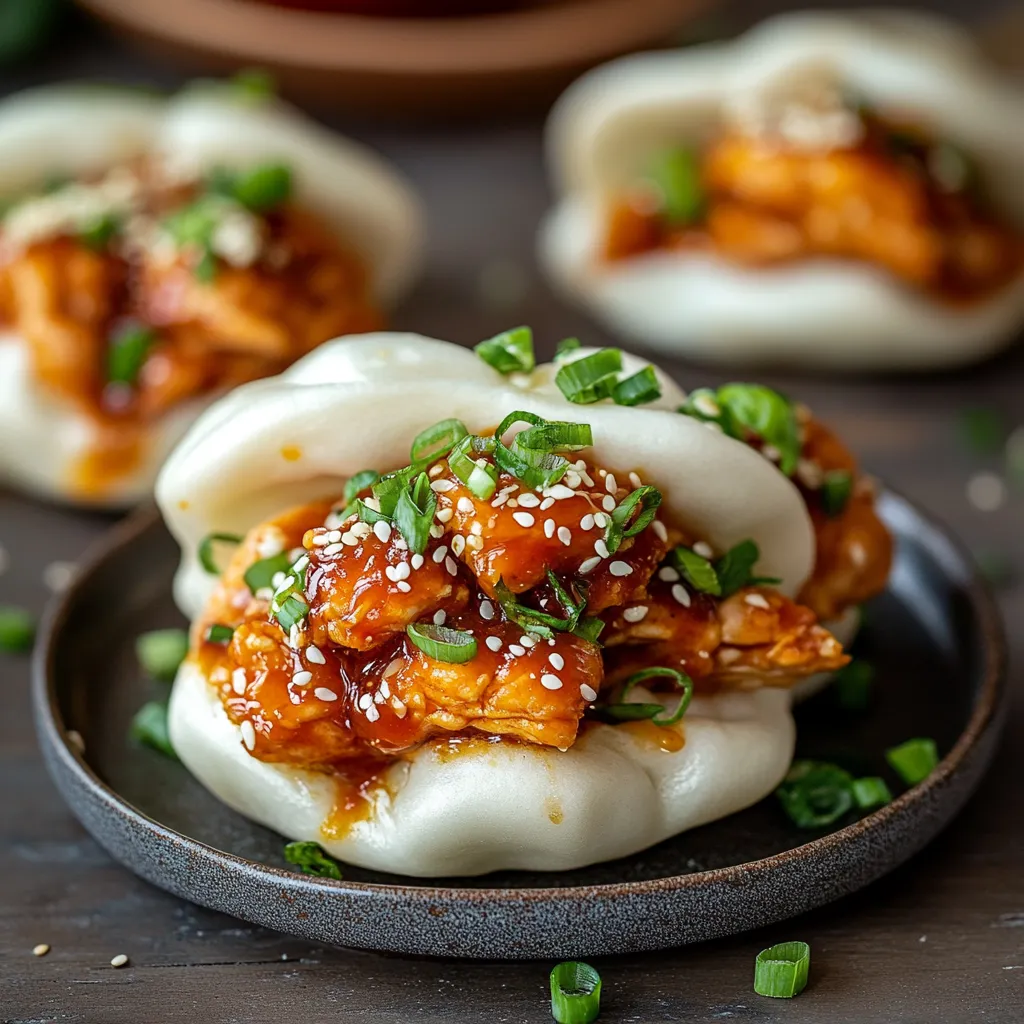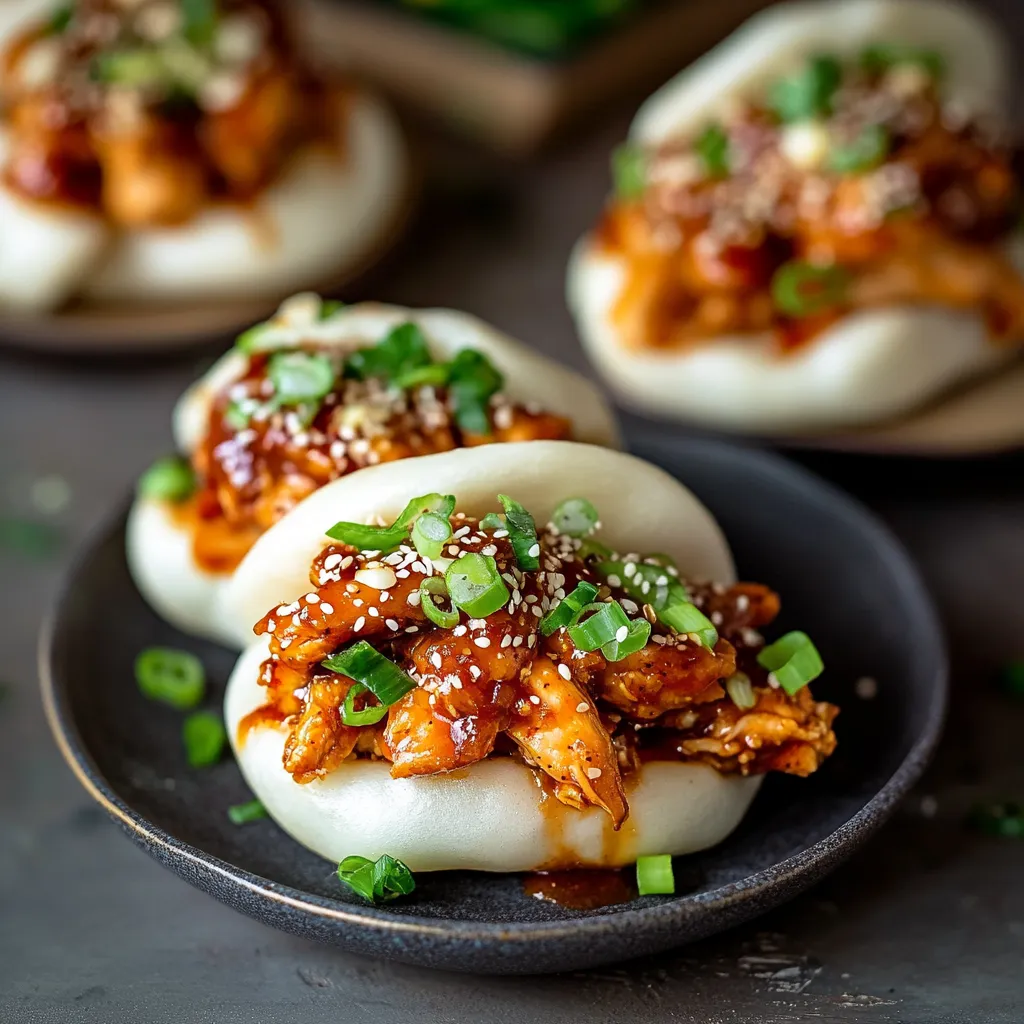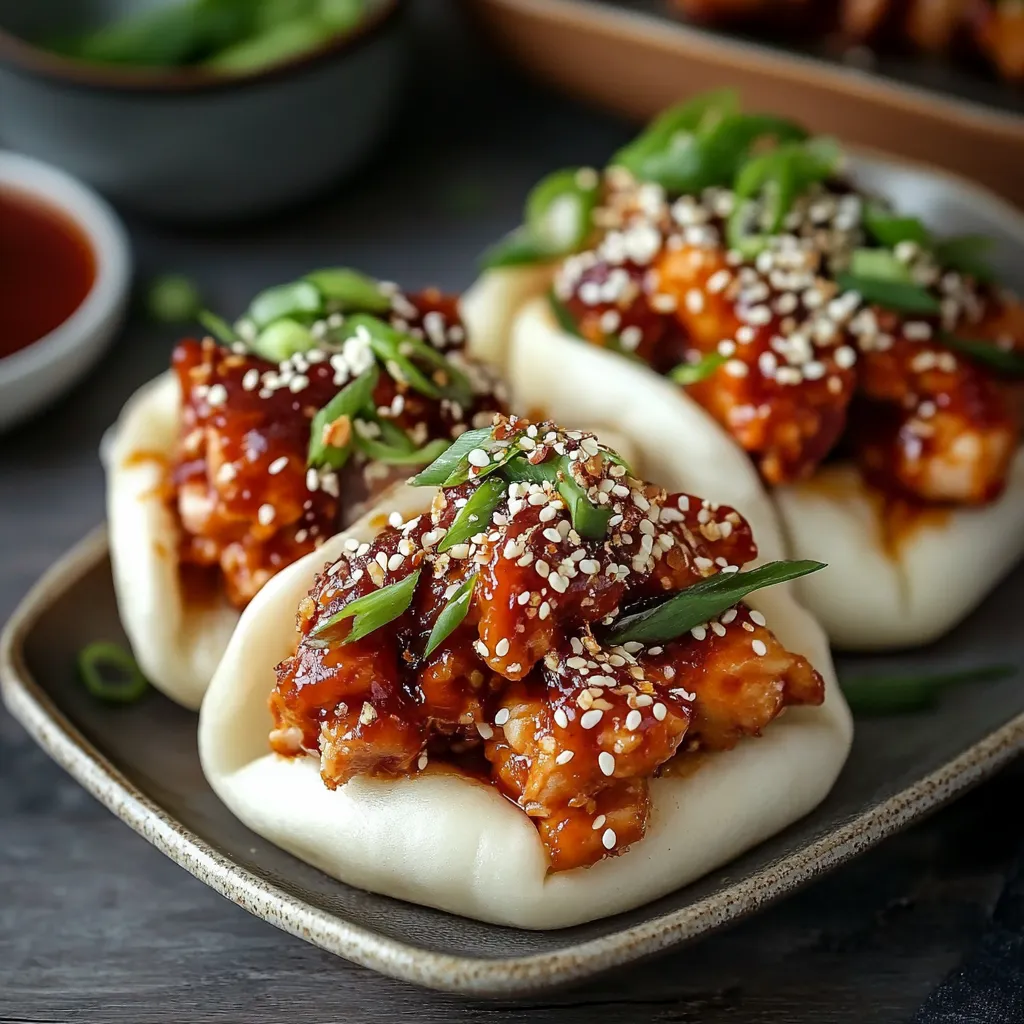 Pin it
Pin it
This savory Korean Chicken Bao has become my secret weapon for dinner parties where I want to wow guests without spending days in the kitchen. The combination of pillowy steamed buns filled with crispy, sweet-spicy chicken creates that perfect handheld bite that everyone raves about.
I first made these for a casual game night with friends, and they disappeared so quickly I barely got one myself. Now they're requested at nearly every gathering, and I've perfected the technique to make them foolproof.
Ingredients
- For the Bao Buns: Plain flour provides the perfect texture for soft, pillowy buns. Look for all-purpose flour with moderate protein content
- Caster sugar: Adds subtle sweetness that balances the savory filling. Regular granulated works but dissolves less evenly
- Instant dried yeast: Ensures reliable rising. Check expiration dates for best results
- Whole milk: Contributes richness to the dough. Full-fat variety yields best texture
- Unsalted butter: Adds tenderness to the buns. Room temperature is crucial for proper incorporation
- For the Chicken: Chicken breasts work perfectly when cut into bite-sized pieces. Look for plump, even-sized pieces for consistent cooking
- Buttermilk: Tenderizes the meat while adding tang. In a pinch, mix regular milk with a tablespoon of lemon juice
- Flour coating with mixed spices: Creates the perfect crispy exterior. Measure precisely for best results
- Gochujang paste: Provides the signature Korean flavor. Find it in Asian markets or international grocery aisles
- Honey: Balances the heat with natural sweetness. Local honey adds subtle floral notes
- For Serving: Fresh cucumber adds cooling crunch. English cucumbers have fewer seeds and work beautifully
- Red onion: Provides sharp contrast to the sweet sauce. Slice paper-thin for best texture
- Fresh coriander: Brings brightness to each bite. Don't skip this ingredient if possible
- Sesame seeds: Add visual appeal and subtle nuttiness. The mix of black and white creates beautiful contrast
Step-by-Step Instructions
- Prepare the Bao Dough:
- Combine dry ingredients first, whisking flour, sugar, salt and yeast in a large bowl until evenly distributed. This ensures the yeast and salt are properly dispersed throughout the dough. Mix the warm water, milk and softened butter separately, ensuring the water is just warm enough to melt butter without killing the yeast approximately 110°F or warm to the touch but not hot.
- Knead to Perfection:
- Work the dough vigorously for a full 10 minutes until smooth and elastic. The dough should spring back when poked gently with your finger. This develops the gluten structure needed for those fluffy buns. Place in an oiled bowl, cover completely, and allow to rise in a warm spot until doubled in size, which typically takes 90 minutes to 2 hours depending on your kitchen temperature.
- Shape the Buns:
- After the initial rise, divide the dough into 20 equal portions. For perfect consistency, weigh each piece on a kitchen scale. Roll each portion into an oval shape approximately 6cm x 9cm on parchment paper to prevent sticking. Brush with olive oil then fold over using a chopstick placed in the center to create that classic bao shape with a small air pocket in the fold.
- Second Rise:
- Place each shaped bun on its own small square of parchment paper to make handling easier later. Arrange on baking trays with space between each, then cover loosely without touching the dough surface. Allow to rise again for one hour until noticeably puffed up. This second rise is crucial for achieving the perfect texture.
- Marinate the Chicken:
- While the dough rises, cut chicken breasts into even bite-sized pieces and place in a bowl. Pour buttermilk over them, adding salt, white pepper and garlic salt. Mix thoroughly to coat each piece, then cover and refrigerate for at least one hour or up to overnight. The buttermilk tenderizes the meat while adding flavor and helps the coating adhere.
- Prepare Crispy Coating:
- Mix together flour and all seasonings in a shallow dish until thoroughly combined. The blend of salt, peppers, herbs and spices creates layers of flavor in the crispy coating. Make sure to break up any clumps of spices for even distribution throughout the mixture.
- Fry to Golden Perfection:
- Heat oil to 350°F in a deep pan or fryer. Working in batches to avoid overcrowding, dredge marinated chicken pieces in the seasoned flour, ensuring complete coverage with a thick layer. Carefully lower into hot oil and fry for 3-5 minutes until deeply golden and cooked through to 165°F internal temperature. Place on a wire rack over a baking sheet in a warm oven to maintain crispness while cooking remaining batches.
- Steam the Bao Buns:
- Bring water to a rolling boil in a steamer. Working in batches, place buns on their parchment squares in the steamer, allowing space between each for expansion. Cover with a tight-fitting lid and steam for exactly 10 minutes until puffy and cooked through. Transfer to a cloth-lined container and cover to keep warm and prevent drying.
- Create the Korean Sauce:
- Combine gochujang, honey, brown sugar, soy sauce, minced garlic, ginger, vegetable oil and sesame oil in a saucepan. Bring to a gentle boil while stirring constantly to prevent scorching, then reduce heat and simmer for 5 minutes until glossy and slightly thickened. The sauce should coat the back of a spoon but still be pourable.
- Assemble and Serve:
- Toss the fried chicken pieces in the warm Korean sauce until thoroughly coated. Gently open each steamed bun and fill with saucy chicken. Top with thinly sliced red onion, cucumber pieces, fresh coriander leaves, and a sprinkle of mixed sesame seeds. Serve immediately while still warm for the best texture and flavor experience.
 Pin it
Pin it
The gochujang paste is truly the heart of this recipe. I discovered it years ago at a local Asian market and have been obsessed ever since. Its complex sweet heat creates that distinctive Korean flavor that makes these baos so addictive and unlike any other chicken sandwich you've tried.
Make-Ahead Tips
The bao dough can be prepared up to 24 hours in advance and refrigerated after the first rise. Simply punch down, cover tightly with plastic wrap, and store in the refrigerator. When ready to use, allow the dough to come to room temperature for about 30 minutes before shaping into buns. This slow rise actually develops more flavor in the dough.
Perfect Pairings
Serve these Korean Chicken Baos with quick pickled vegetables on the side for a refreshing contrast to the rich, spicy chicken. Simply combine thinly sliced carrots, radishes and cucumber with rice vinegar, a pinch of sugar and salt, and let sit for 30 minutes before serving. The acidic crunch complements the soft buns and spicy chicken perfectly.
Pro Tips
Always maintain the oil temperature between 350-375°F for perfectly crispy chicken. Too hot and it burns before cooking through, too cool and it becomes greasy.
 Pin it
Pin it
These Korean Chicken Baos showcase restaurant-worthy results with a homemade touch, sure to leave your guests amazed.
Frequently Asked Questions
- → Can I make the bao buns ahead of time?
Yes! You can prepare the bao buns in advance. Steam them completely, then allow to cool. Store in an airtight container in the refrigerator for up to 2 days or freeze for up to 3 months. To reheat, steam the buns again for 2-3 minutes until hot and soft.
- → How spicy is the Korean chicken?
The spice level is moderate due to the gochujang paste. You can easily adjust the heat by reducing the amount of gochujang or chili flakes in the recipe. For a milder version, use 1 tablespoon of gochujang instead of 2, or increase it for extra heat.
- → What can I substitute for buttermilk?
If you don't have buttermilk, you can make a substitute by adding 1 tablespoon of lemon juice or white vinegar to 1 cup of regular milk. Let it sit for 5-10 minutes until slightly thickened before using in the marinade.
- → Can I use chicken thighs instead of breast?
Absolutely! Chicken thighs work wonderfully in this recipe and often provide more moisture and flavor. Boneless, skinless thighs can be cut into similar bite-sized pieces and used following the same instructions.
- → What if I don't have a steamer for the bao buns?
You can create a makeshift steamer by placing a wire rack or heatproof plate in a large pot with water at the bottom (ensuring the water doesn't touch the rack). Cover with a tight-fitting lid and steam as directed. Alternatively, bamboo steamer baskets work excellently and are relatively inexpensive.
- → What sides pair well with Korean chicken bao?
These bao buns pair wonderfully with sides like kimchi, pickled vegetables, Asian slaw, or a simple cucumber salad. For a fuller meal, consider serving with steamed rice or Korean-style potato salad.
